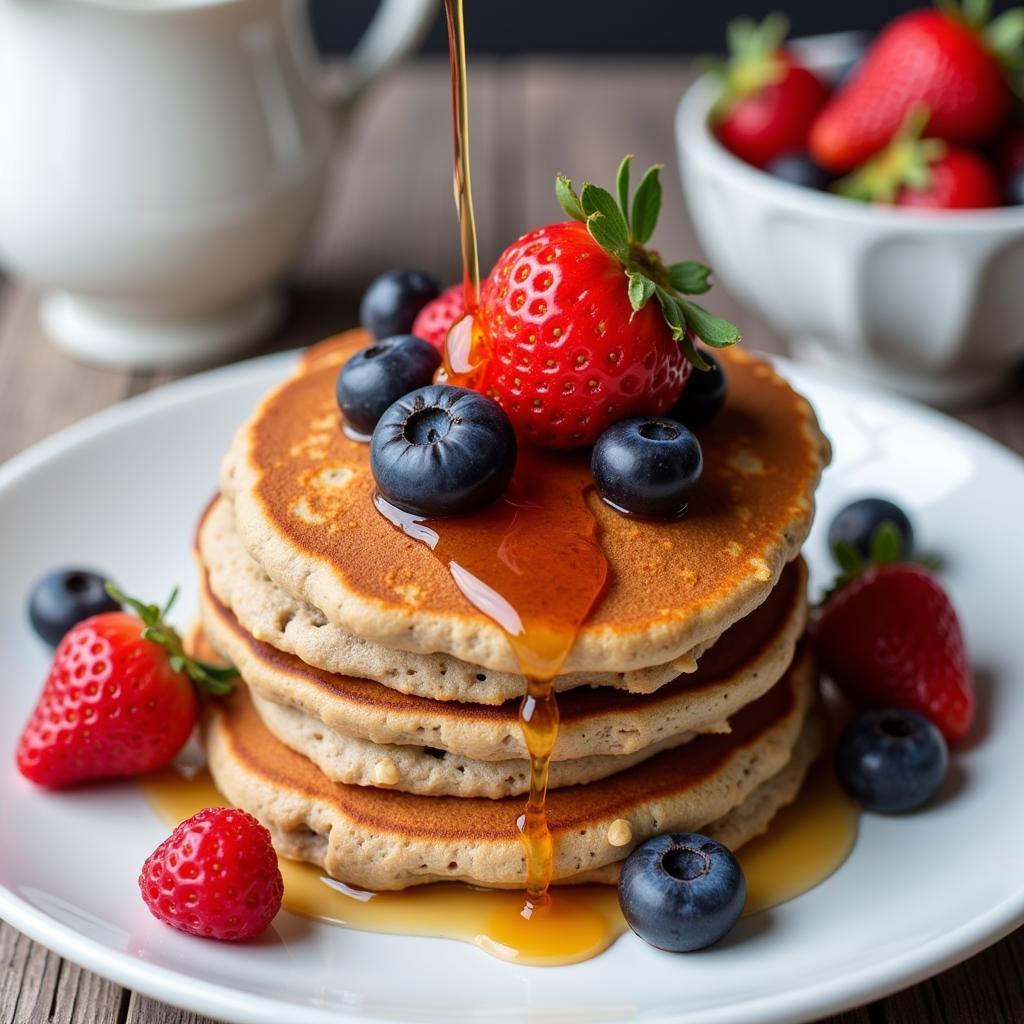Buckwheat, despite its name, is not a type of wheat at all but a gluten-free seed related to rhubarb. While commonly mistaken as a grain, buckwheat stands apart with its impressive nutritional profile and unique culinary versatility, making “Buckwheat Food Products” a term worth exploring for health-conscious eaters and adventurous foodies alike.
A Nutritional Powerhouse: Why Choose Buckwheat?
Buckwheat boasts an impressive nutritional resume. It’s a good source of:
- Protein: Unlike many grains, buckwheat offers a complete protein, meaning it contains all nine essential amino acids.
- Fiber: Both soluble and insoluble fiber are abundant in buckwheat, supporting digestion and promoting gut health.
- Minerals: Buckwheat is rich in manganese, copper, magnesium, iron, and phosphorus, all essential for various bodily functions.
- Antioxidants: Compounds like rutin and quercetin contribute to buckwheat’s antioxidant properties, protecting your cells from damage.
These nutritional benefits make buckwheat a valuable addition to any diet, particularly for individuals with gluten sensitivities, celiac disease, or those simply looking for more nutritious alternatives to refined grains.
Beyond the Grain: Exploring Buckwheat Food Products
Buckwheat’s culinary uses are surprisingly diverse. Let’s delve into some popular buckwheat food products:
1. Buckwheat Groats: The Foundation of Flavor
Buckwheat groats are the hulled seeds of the buckwheat plant. They come in different forms:
- Whole Groats: These unroasted groats have a chewy texture and a mildly nutty flavor, perfect for adding to soups, stews, or salads.
- Kasha: Roasted buckwheat groats, known as kasha, have a deeper, more intense flavor and a crunchy texture. They are commonly used in pilafs, stuffings, and as a breakfast porridge.
 Buckwheat Pancakes for Breakfast
Buckwheat Pancakes for Breakfast
2. Buckwheat Flour: Baking with a Healthy Twist
Ground from buckwheat groats, buckwheat flour is a popular gluten-free alternative in baking. Its earthy and slightly bitter taste adds depth to:
- Pancakes and Waffles: Buckwheat flour lends a unique texture and nutty flavor to breakfast favorites.
- Bread and Muffins: While it won’t rise as much as wheat flour, buckwheat flour creates dense, flavorful baked goods.
- Noodles and Pasta: From Japanese soba noodles to Italian pizzoccheri, buckwheat flour is a staple ingredient in many traditional noodle dishes.
3. Buckwheat Tea: A Soothing and Flavorful Beverage
Roasted buckwheat groats are steeped in hot water to create a naturally caffeine-free tea called sobacha in Japan. This comforting drink boasts a toasty, nutty flavor and is often enjoyed for its potential health benefits.
Incorporating Buckwheat Food Products Into Your Diet
Adding buckwheat to your diet doesn’t require a culinary overhaul. Here are simple ways to get started:
- Start with breakfast: Swap your regular oatmeal with a warm bowl of buckwheat porridge topped with fruit and nuts.
- Boost your salads: Toss in a handful of cooked buckwheat groats for added texture and protein.
- Get adventurous with baking: Experiment with buckwheat flour in your favorite pancake or muffin recipes.
- Explore global cuisines: Discover the unique flavors of buckwheat noodles in Japanese soba or Korean japchae.
Buckwheat Food Products: A World of Flavor and Nutrition Awaits
Buckwheat food products offer a world of culinary possibilities while providing a wealth of health benefits. From hearty breakfast porridges to comforting noodle dishes and gluten-free baking alternatives, there’s a buckwheat product to satisfy every palate and dietary need. Embrace the versatility of buckwheat and discover a new dimension of flavor and nutrition in your kitchen.
FAQs about Buckwheat
1. What does buckwheat taste like?
Buckwheat has a distinctive earthy and nutty flavor, with a slight bitterness that mellows out with cooking.
2. Is buckwheat safe for people with gluten allergies?
Yes, despite its name, buckwheat is naturally gluten-free and safe for people with celiac disease or gluten sensitivities.
3. How can I cook buckwheat groats?
Rinse the groats and toast them in a dry pan for a nuttier flavor (optional). Then, combine with water or broth in a 2:1 ratio and simmer until tender, about 15-20 minutes.
4. Can I substitute buckwheat flour for regular flour in recipes?
Buckwheat flour can be substituted for a portion of regular flour in baking, but it won’t rise as much due to its lack of gluten. You may need to adjust liquid ratios and add binding agents like xanthan gum.
5. Where can I buy buckwheat food products?
You can find buckwheat groats, flour, and other products at most health food stores, well-stocked supermarkets, and online retailers specializing in Russian food store online.
6. What are some other interesting buckwheat products to try?
Beyond the basics, look for buckwheat noodles (soba), buckwheat crackers, buckwheat pancakes mixes, and even buckwheat-based granola bars.
7. Are there any dishes or cuisines that commonly use buckwheat?
Yes! Japanese soba noodles, Russian kasha, Korean japchae, French galettes, and Italian pizzoccheri are just a few examples of dishes and cuisines that feature buckwheat prominently.
Need help exploring the world of buckwheat and other corn free diet foods?
Contact us! We’re here to help you discover a world of delicious and exotic food gifts and unique USA made food products, including a variety of options for those looking to buy Russian food online. Call us at 02437655121, email us at minacones@gmail.com, or visit our store located at 3PGH+8R9, ĐT70A, thôn Trung, Bắc Từ Liêm, Hà Nội, Việt Nam. Our dedicated customer service team is available 24/7 to assist you.